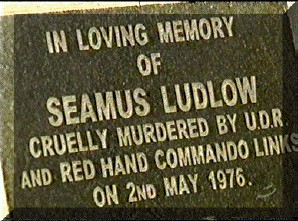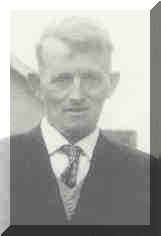


The Murder of Seamus Ludlow in County Louth, May 1976. Towards a public inquiry?
|
The Murder of Seamus Ludlow in County Louth, May 1976. Towards a public inquiry? |
|
|
The Dundalk Democrat, 7 September 2005: Seamus Ludlow murder is now officially an unlawful killing by Anne Marie Eaton The 1976 murder of Seamus Ludlow is now officially an unlawful killing, following a two day inquest. A jury of four women and six men returned the unanimous verdict. Seamus, a 47 year old forestry worker was shot three times in the chest and his body dumped over a ditch just off the Bog Road in Mountpleasant, Dundalk. The Ludlow family speaking on the steps of Dundalk courthouse said they were pleased that information they had obtained on Seamus' murder was at last being made public by the state including:
Retired Chief Superintendent Ted Murphy who had looked into the entire case and inquest in the late 1990s said that four men came to Dundalk with the intention of killing someone. "It didn't matter who as far as I can see," he said. The jury also heard that only one of the three bullets was located. Seamus' nephew Jimmy Sharkey said that the family are now eagerly awaiting the publication of the Barron Report and will continue in their campaign for a public inquiry. "It is now on public record that four names were given to the Gardai in 1979 but no investigation was allowed. Who made that decision? Who stopped the case going further? "This inquest has moved us on but there is still a lot more to be made public."
News Special: The Ludlow murder inquest Gardai admit knowledge of suspects in Ludlow murder By Anne Marie Eaton Two suspects in the murder of Seamus Ludlow, made known to the Gardai in 1979 but not questioned by RUC officials until 1998, both gave accurate accounts of the murder. Retired Chief Superintendent Ted Murphy was instructed in October 1996 to look into the Ludlow murder investigation and the august 1976 inquest. He told the inquest jury and county Coroner Ronan Maguire that the two suspects gave a description of how the shooting took place and where the body was dumped. It was, he said, fairly factual information on the Ludlow murder and added: "There was no other murder with similar circumstances at the time." He said that the suspects were questioned in Castlereagh where Gardai were present to assist. The DPP in Northern Ireland did not take the mater any further. When he was asked if there was any motive for the murder the retired Chief Superintendent said: "It seems extremely unlikely. Four persons came from Northern Ireland to kill. It didn't matter who as far as I can see. "Seamus Ludlow was a highly regarded man in society. He had no enemies. He was an inoffensive quiet man. There was no motive. It was a random incident." When asked about the rumours of IRA involvement in the murder, he said his investigations had shown there was a rumour that had circulated locally that the IRA were involved. He had heard this from a number of people he had spoken to. On the subject of Seamus Ludlow's clothing and the bullets recovered from the body, Mr Murphy said "with the exception of one bullet there were no other exhibits." He said it as because of this that Garda offices in Dundalk, Drogheda, Dublin and Dromad were searched. "To be sure we were not missing any documentation we searched these offices." He also stressed that the Ludlow family had assisted him in his work. "I was very impressed with the level of co-operation given by this the family, three generations I believe. "They weren't notified of the inquest (in 1976) and there was no documentation to see who was given the task."
Brother told that family member was uninvolved in brutal murder Kevin Ludlow waited 29 years to be given a chance to put his own deposition on record. On May 2 1976 he had met then Sergeant Jim Gannon on the Bog Road amnd when he told him his brother Seamus was missing was brought over to identify a body in a ditch. He told the inquest that in the years since (he) had met with the now retired Sergeant and said he was repeatedly told that Seamus had been murdered by the IRA. In 1995 he said he was told by Mr Gannon that a family member had been involved in the killing. "He said he'd pin it on him yet." When asked had he made the comment to Kevin Ludlow about a family involvement in the murder he said "I would say that is incorrect." Sgt Gannon said he had not been given the task of contacting Kevin Ludlow. "The first thing I heard about Seamus Ludlow's inquest was 10am that morning. "I received a phone call from Frank Murray in Dundalk. "I got on to Dundalk and arranged for a car to go to the Ludlow house immediately. Kevin was in Newry. "I wasn't given the task. I never found out who was given the task."
I sent it to the top of the chain . . . nothing came back Retired Chief Supt John Courtney said senior Gardai at headquarters had stopped him from questioning strong suspects in the murder of Seamus Ludlow in the late seventies. An assistant to Supt Dick Fahy in the murder investigation, he added he was not aware of Gardai telling Seamus' family that the IRA had killed Seamus and that if he had known he would not have allowed it. The Ludlow family listened intently as he said that he had been in Belfast in Feb 1979 working on another investigation. He was introduced to a detective sergeant and detective constable and told they might be able to help with the investigation into Seamus Ludlow's murder. He was given names and addresses of strong suspects in the murder case and was given information around the murder itself. The retired chief supt said he passed the information through the proper channels through to Gardai headquarters C3 "subversive division" at the time. "I was anxious to interview them and looked for authorisation but I didn't get it. I got onto a detective sergeant in C3 who said the man in charge wouldn't do anything about it. They were taking no action. "I did no more. What could I do. I had my part done. I tried to get permission to interview but it was denied. I could do no more." When it put to him that for 20 years the impression was created that Seamus had been murdered by the IRA he said: "We eliminated the IRA after two or three months", but added that this would not have been written on a case file. Of Gardai telling the family of an IRA involvement he said: "Nobody told me and I wouldn't have tolerated it. No Gardai came to me to say there was IRA involvement." Representing the Ludlow family Ms Deirdre Murphy asked: "You sent it through proper channels to the top of the chain?", to which he replied: "Nothing came back." Fatal bullets fired from inches Former State Pathologist Professor John Harbison said that Seamus Ludlow's killer had fired the gun from only inches away. A black powder residue found at two of the entry wounds would suggest the gun was fired within a six inch distance. The final shot, he said, struck the back of the left hand near or at contact range. It exited the hand and entered the chest sideways. The bullet then went through the heart and left lung, lodging in the back muscles. It was later retrieved by Prof Harbison with the aid of a post mortem x-ray. Prof Harbison said he felt Mr Ludlow could have been shielding himself from the gun and that was why a bullet went through his hand. Another bullet entered the left side of the chest, also at near or contact range. The bullet crossed the body via the stomach, liver, right lung and emerged via the exit wound. Prof Harbison said that this shot alone would have been fatal bit if so then death would have been slower. A third bullet entered the right side of the chest with entry and exit wounds close together. The bullet crossed to the inside of the right arm where it also entered and exited closer together. He also explained how the bullets were retrieved. One fell from clothing as the body was being removed at the scene, while another was retrieved at the mortuary. A third bullet was removed from the body by Prof Harbison. While bullet holes were located on Seamus' jacket and overcoat, Professor Harbison said he did not know how they came to be lying over him by the time he arrived at the scene. It was fair to conclude he had been wearing them when shot, he agreed.
I Top I SUPPORT THE SEAMUS LUDLOW APPEAL FUND Bank of Ireland 78 Clanbrassil Street Dundalk County Louth IrelandAccount No. 70037984
I Home I I Top I I First Ludlow Site I I Domain Name Site I I Questions I I Chronology I I Brief Review I I Profile I I Report I I Photographs I I Ludlow family's Letter to the RUC Chief Constable I I Latest Reports I I Hamilton Inquiry I I Contributors I I Linda Porra's Editorial I I Jim J. Kane's Letter to the Northern Ireland Human Rights Commission I I Jim J. Kane's Letter to the RUC I I Press Release I I 25th Anniversary I Ludlow family letter to Bertie Ahern I I Ed Moloney Interview I I Meeting the Police Ombudsman I I Links I I New Guest Book I I E-Mail Form I I Mailing List I I Tell a Friend I Chronology: 1 2 3 4 5 6
|